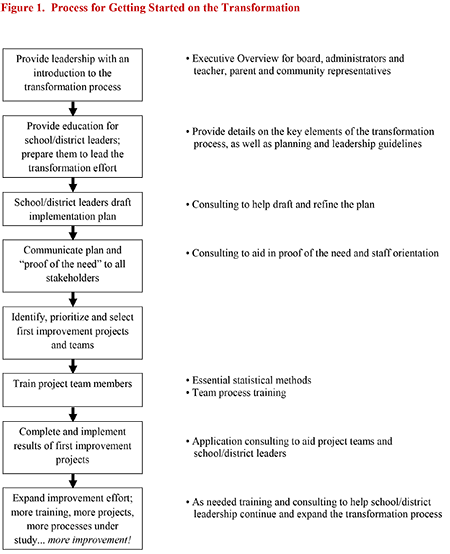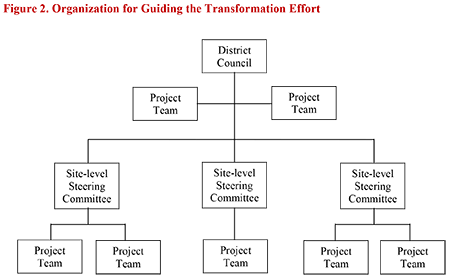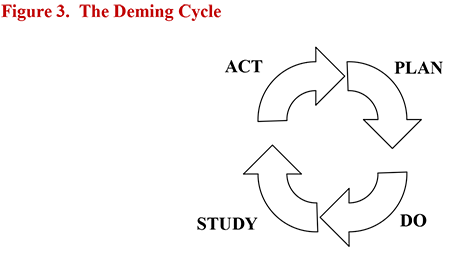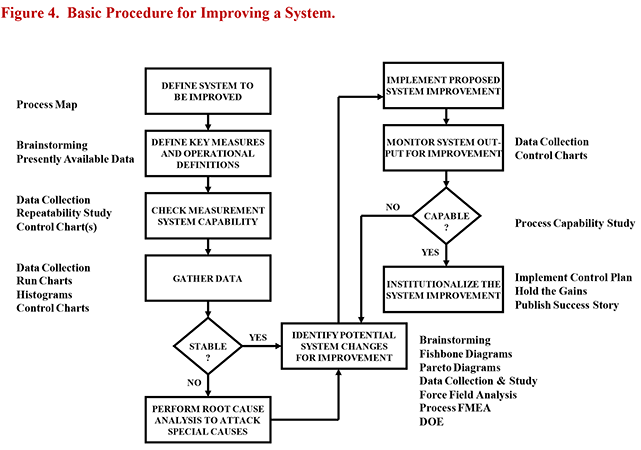Getting Started on the Transformation
Guidelines for Planning and Introducing the Principles of Dr. W. Edwards Deming in a K-12 District or School Setting
Recently, a series of blogs was posted on www.jimleonardpi.com that presented and expanded upon the following restatement of Dr. W. Edwards Deming’s 14 Points for Management as “Obligations of the School Board and Administration.” The 14th Obligation reads, “Plan and take action to accomplish the transformation.” In this essay, a process and guidelines will be provided for planning and getting started on the transformation at a K-12 school or district level. (With minor edits, the same guidelines can apply to business organizations.)
Obligations of the School Board and Administration
- Create constancy of purpose toward improvement of the entire school system and its services.
- Adopt the new philosophy. We are in a new economic age.
- Cease dependence on tests and grades to measure quality.
- Cease dependence on price alone when selecting the curriculum, texts, equipment and supplies for the system.
- Improve constantly and forever every process for planning, teaching, learning and service.
- Institute more thorough, better job-related training.
- Institute leadership (i.e., management of people).
- Drive out fear.
- Break down barriers between groups in the school system.
- Eliminate the use of goals, targets and slogans to encourage performance.
- Closely examine the impact of teaching standards and the system of grading student performance.
- Remove barriers that rob staff and administrators of pride of workmanship and that rob students of the joy of learning. This means, inter alia, abolish staff ranking and the system of grading student performance.
- Institute a vigorous program of education and self-improvement for everyone in the system. Don’t forget the needs of parents.
- Plan and take action to accomplish the transformation.
In the spirit of the 14th Obligation, Dr. Deming provided the following suggestions (among others) for getting started on the transformation.1
- Management in authority will struggle with over every one of the [14 points]…. They will agree on their meaning and on the direction to take. They will agree to carry out the new philosophy.
- Management in authority will take pride in their adoption of the new philosophy and in their new responsibilities. They will have the courage to break with tradition, even to the point of exile among their peers.
- Management in authority will explain by seminars and other means to a critical mass of people why change is necessary, and that the change will involve everybody.
- Start as soon as possible to construct with deliberate speed an organization to guide continual improvement of quality….
- Everyone can take part in a team. The aim of a team is to improve the input and the output of any stage [of a process]. A team may well be composed of people from different areas….
Figure 1 illustrates a sequence of events for initiating the transformation process at a school or district level. Next to the events are listed types of assistance educators may seek from consultants, professional organizations, business partners and other external resources.

Because every district is unique, these events and their sequence may vary in actual practice. They are offered as general planning guidelines. The balance of this paper will provide some more details on the general guidelines for getting started on the transformation process.
Event 1. Provide leadership with an introduction to the transformation process.
This first event may involve a general orientation session or executive overview for school and district leaders. The target audience for this event includes senior administrators and board members as well as representatives from teachers, parent groups, staff, business partners and the community. It may take the form of a full-day workshop that covers the key elements of the transformation process as well as a general description of how a school or district may proceed from that point.
The objective of this first event is not to change a leader’s behavior. Rather, it’s to put school and district leaders in a position to make a decision: Do we want to learn more about this approach or not? If the decision is to learn some more, the group would proceed to the second event in the sequence.
Event 2. Provide education for school and district leaders.
In this event, more formal education is provided to school and district leaders in order to prepare them to lead the transformation effort at a local level. Those receiving such training should include board representatives, administrators from both central office and building levels and site-based decision-making team members, as well as teacher and parent representatives. If possible, representatives from other components of the local community should be included, such as local business partners, administrators or faculty from higher education (two- or four-year institutions) and local government officials.
The education provided at this stage of the process should include, at a minimum, details on each of the key elements of the transformation process: adopting a systems perspective, applying statistical methods, and providing leadership to create and maintain a healthy environment for work, learning and continuous improvement. Details on Deming’s principles, profound knowledge and appropriate statistical methods and concepts should also be a part of the training planned and provided during this event.2
As part of the training, frequent opportunities should be provided for those attending to apply the tools and concepts to their own local concerns and issues. This can be accomplished via:
- Application of the basic tools (brainstorming, cause-and-effect analysis, voting and ranking, Pareto analysis, and so on) to specific concerns such as student motivation, disciplinary issues, communication and barriers between buildings and groups.
- Use of school and district data (test scores, disciplinary referrals, survey data) in any intermediate statistical methods taught in the training program.
Finally, some guidelines – including opportunities to apply them – should be provided for helping school and district leaders begin to draft their initial implementation plan. Such guidelines should address the establishment of specific and feasible action steps for completing the next five events in the process.
Event 3. Draft implementation plan.
Recall Deming’s suggestion to “construct with deliberate speed an organization to guide continual improvement.”3 In many districts, this organization will take the form of steering committees at both central office and site levels. Figure 2 shows a typical infrastructure for guiding the transformation effort.

At the central office level, a district council will be formed with the charter to plan and provide direction for the implementation of the new philosophy throughout the district. Beyond its planning and leadership responsibilities, the district council will form and charter project teams to tackle issues that cut across school and program lines. In Deming’s view, the aim of such teams is to improve processes. Among the projects directed by this group will be teams working on staff development, curriculum design, budgeting, broad community relations and business partnerships, or other district-wide issues.
At a school level, steering committees will be formed with the charter to plan and direct the transformation process within that site. These committees will form teams to tackle intra-school issues derived from local concerns and priorities. For example, one school may be more concerned right now about student discipline than others. Therefore, that steering committee will form a project team to deal with that issue. Another school may be more concerned about school-to-home communication or about reading achievement levels than others. So, that steering committee will form teams to study causes of those problems and to recommend program and process changes to improve the situation.
Of course, before forming any teams or taking on any specific projects, district and school leaders must draft their overall implementation plan. In the absence of a solid plan, future steps could cause confusion and frustration among stakeholders. That’s because such action may come across as isolated events, as opposed to logical steps in a well-thought-out plan for accomplishing the transformation. Most organizations will see little progress unless the following are clearly delineated in the plan.
- Specific, feasible, clearly defined action steps
- Assigned responsibilities (champions) for each action step
- Checkpoints (or target dates) for completing or reviewing progress on each agreed-upon action step
The general goals or areas of emphasis provided by many strategic plans are not sufficient in this third event for getting started on the transformation. Rather, what is required is a sound plan that provides specific answers to the question, “Who is going to do what and when?”
Planning Guidelines
At both a district and site level, initial implementation plans should address such topics as customer and community relations, training, projects and teams, supplier relations, communication and measurement. Examples of specific action steps for the plan are listed below under just two of the major categories: training and projects and teams.
Plan topic: Training
Action steps Champion Target date
Complete initial training for key leaders
Select training coordinator
Select potential in-house resources (future trainers, facilitators,
“in-house statisticians”)
Provide statistical methods training for…
• Initial project teams
• Other staff members
Provide team process training for…
• Initial project teams
• Other staff members
Draft school-wide training plan
Train in-house resources in…
• Statistical methods
• Team process concepts and techniques
• Advanced tools, as appropriate
Implement staff training in…
• Job skills
• Work methods
• Appropriate statistical methods
Plan topic: Projects and teams
Action steps Champion Target date
List potential projects
Select and define initial project(s)
Select team members and provide training
Draft procedure for selecting, assigning and managing future projects
Complete and integrate results of first project(s)
Implement process for reviewing and nurture future project teams’
progress
Establish system to communicate project teams’ progress and
accomplishments
Initiate more projects
Event 4. Communicate the plan and “Proof of the Need” to all stakeholders.
This event is designed to address Deming’s advice that leaders explain to people why the transformation is necessary in the first place. Deming’s contemporary and fellow consultant, Dr. Joseph M. Juran, taught a “sequence for breakthrough,” which was a project-by-project, problem-solving approach to improving quality. Juran noted that both breakthrough and control are necessary for survival and health of a company. He defined “breakthrough” as the organized creation of beneficial change, whereas control is the prevention of bad changes.4
As an early step in Juran’s sequence, middle managers and staff members may have to prove the need to higher levels of management to charter and support an improvement project. Such proof of the need may be provided by quality cost figures, awareness of new forces that have an impact on quality, legislative issues and other sources.5
In this fourth event for getting started on the transformation, we use the same phrase – proof of the need – but in a much broader context. Here we are talking about a very carefully designed, highly controlled communication and orientation effort for staff members and other stakeholders throughout the district. The goal of the orientation is to prove the need to incur the pain of the transformation! In essence, school and district leadership ties to very clearly and very candidly communicate the following:
- The need to change the system in order not just to survive, but to thrive as a viable educational community
- School and district leadership’s resolve and commitment to accomplish the required transformation
The primary vehicle for providing meaningful proof of the need is a well-planned series of information meetings. Information shared in such meetings may include:
♦ Introduction and comments by Board chair, superintendent or other senior administrator
♦ Evidence of the need for dramatic improvements in American education, for example:
• In a recent round of international testing among 34 nations, American students ranked 25th in math and 17th in science.6
• The Alliance for Excellent Education reports that in 2011 barely 69 percent of American students graduated from high school. Among minority students, only 56 percent of Hispanic, 54 percent of African American, and 51 percent of American Indian and Alaska Native students in the U.S. graduated with a regular diploma, compared to 77 percent of white students and 81 percent of Asian Americans.7
♦ Description of major opportunities for improvement that may exist in the school or district (for example, local employer needs, community concerns, dropout rate, assessment data, disciplinary incidents)
♦ Examples of some of the dramatic changes underway in schools and districts where quality and improvement have become the primary focus
♦ Brief overview of the Deming philosophy
♦ Review of school or district mission statement and what it means
♦ Review of what the board, administration and others have done to date (for example, time spent in training, steering committee meetings, planning, surveys)
♦ Overview of school and district leaders’ plans for future activities
Steering committee members may look forward to two positive outcomes of the proof of the need effort. First, they begin to educate the staff and local community about the problems of education. Second, they are able to gauge staff, parent and community openness to the transformation, based on comments and feedback after the orientation and information meetings.
In the wake of their proof of the need meetings, school and district leaders should keep their eyes and ears open for what I sometimes refer to as “the crazy people.” These are staff members, administrators, parents and others who approach leaders after the orientation sessions and say, “I’d really like to learn more about this!” Such indications of interest help steering committees to identify potential team members for their initial improvement projects.
Event 5. Identify, prioritize and select the first improvement projects and teams.
In the infrastructure illustrated in Figure 2 above, the multidisciplined project team serves as the workhorse for improving teaching, learning and administrative processes. Juran observed that as one moves from a small, self-contained department, mobilizing for improvement becomes more complex.8 Therefore, representatives and knowledge from different groups or perspectives are needed to adequately address systems problems and opportunities for systemic improvement.
The fifth event in the process for getting started on the transformation involves selecting just the first one or two – never more than three – projects for multidisciplined teams. After all, leaders must keep the airplane flying while transforming it into a starship. Therefore, it is recommended that districts start on a small scale, learn from first few projects applications, and then expand the effort.
Deming wrote about the Shewhart cycle for learning and improvement. (That model is illustrated in Figure 3 under its more common title, the Deming Cycle.) In the second stage of the cycle, teams carry out a change or test planned in the first stage, “preferably on a small scale.”9 Next, teams summarize what was learned and then take appropriate action to adopt the change, hold gains or to run through the cycle again.

The Deming Cycle is a strategy for improvement that is based on a simple premise: To achieve improvements in quality, one must first plan for them, implement the plan, study the results, and take appropriate action. Sometimes called the PDSA or PDCA cycle, the Deming Cycle is
broken up into four quadrants: Plan, Do, Study and Act. (The “Study” quadrant was once labeled “Check.”)
PLAN Question and theorize. Plan data collection. Plan a change or test. Determine methods to accomplish the change or test.
DO Educate and train those who will be involved in or affected by the plan. Implement the plan. Carry out the change or test.
STUDY Measure the effects of the implementation. Analyze the data. Compare the results to the plan. Summarize what was learned.
ACT Take appropriate action. Revise the theory. Plan to change or to further improve the process.
Candidates for initial improvement projects will be found in survey and test data, strategic plans, staff members’ suggestions, annual reports and other sources. Another excellent source for initial projects may be to review the status of current teams and committees. (Maybe the last thing the district needs is another team!) A current team or project may be pulled under the umbrella of the steering committee and guided through the Basic Procedure for Improving a System, illustrated in Figure 4.

Event 6. Train project team members.
In accordance with the plan developed back in the third event for getting started on the transformation, school and district leaders ensure that appropriate training is provided for members of the initial project teams. At a minimum, training must be provided in appropriate statistical methods with great emphasis on the basic tools. Teamwork or team process training may also be in order.
The effectiveness of any training will be a function of the quality of the subject matter times the probability of use. After training in the basic tools is provided, quick assignment to process improvement projects provides a high probability of use. Conversely, people should not be assigned to project teams without training in the tools and methods they’ll need to be successful.
Seldom have I worked with a school or district that has had to pay a dime for the training of their initial project teams. For example, Dickinson Independent School District outside Houston was able to draw on trainers from Oxy Petrochemicals, a local business partner that had adopted the Deming system of management. School District 51 in Ware Shoals, South Carolina, received training resources and assistance from Greenwood Mills. The school district in Rock Hill, South Carolina, drew upon volunteer trainers and training materials provided by Bowater Paper Company and a local Hoechst-Celanese plant.
In these and other cases, the districts were able to provide training as well as facilitation help for their first teams by drawing upon trainers and resources from local business partners. Even though the school and district leaders did not have to pay for the training programs, however, that does not mean they were free. There was still the expense of staff members’ time in the training sessions and team meetings.
District and school leaders are cautioned to make sure they provide appropriate guidance and coaching for local business people who help out in the initial training. Special emphasis must be placed on the appropriate vocabulary and context for the material that’s presented. When training professional teachers and school staff, if a trainer from a business partner refers to our children as “raw materials” or “products,” the trainer is dead – and so is the district’s training effort!
During the training of the first project teams, school and district leaders should be looking ahead to becoming self-sufficient in the future expansion of the education effort. Therefore, leaders must try to identify current staff members who appear to have strong potential for serving down the road as internal trainers, facilitators for future project teams and “in-house statisticians.” The in-house statisticians will be people to whom others can turn for assistance in analyzing test scores, disciplinary referrals and other data.
These potential internal resource personnel should be scheduled for training in the statistical methods, team process skills and other tools provided for the initial project team members. In this manner, their development will commence so in the future the district can expand the training effort without continuing dependence on external resources.
Event 7. Complete and implement the results of the first improvement projects.
As the initial project teams develop recommendations for improving their assigned processes, school and district leaders accept responsibility for seeing that those changes are implemented. Once improvements occur, steering committees will be able to publicize them and thereby build momentum for the expansion of the transformation effort. (After all, nothing sells like success!)
Though work early in the process for getting started on the transformation generates some success stories for building momentum, a more important outcome of the fist successful projects is more learning. School and district leaders learn what’s involved in leading a successful systems improvement effort. Based on what they learn, plans can be revised for expanding the effort and continuing the transformation.
Event 8. Expand the improvement effort.
The learning that occurs during the first seven events of the process for getting started on the transformation provides a strong foundation for making future progress. In this eighth event, the effort is expanded to involve more people, form new project teams and study more processes. All of this activity leads to more and continuing improvements.
Leadership guided by the system of profound knowledge not only expands the improvement effort; it also succeeds in building the healthy work environment for work, learning and continuous improvement. Never-ending efforts to maintain and strengthen the healthy environment eventually lead the district and its schools to a new state, in which they no longer have the concerns they once had; in which all children experience enrichment and ultimately achieve the status of interdependent self-managers, capable of and excited by the pursuit of continuing, lifelong learning.
Conclusion
Training alone will not accomplish the required transformation of America’s schools. Beyond initial training and education, leadership action is needed. The purpose of this essay was to provide some general guidelines for planning and taking action to get started on the transformation. It can be done. It has been done in schools and districts throughout the U.S. and Canada. Following is a testimonial from one educational leader who was instrumental in helping her district get started on the quality transformation.
"Jim Leonard has been invaluable in helping school employees grasp the concepts of Total Quality Management and the statistical analysis of data. Of all the consultants I have heard present this information, only Mr. Leonard has made it relevant to the field of education. He has also taken the very difficult concepts of statistical analysis of data and provided educators with understandable applications to education.
"Under Jim's guidance, we have applied the tools, principles and concepts to achieve a number of impressive improvements. Local business partners are reporting a much higher level of respect for our district; new behaviors are evident among administrators and teaching staff; and student test scores have shown statistically significant improvement in just a four-year period...." (Dr. Elizabeth Clark, Deputy Superintendent, Hallsville Independent School District, Hallsville, TX)
Dr. Deming once told me that the transformation begins with the individual; all else follows. I hope you find this information to be helpful in getting started or continuing on your personal transformation journey.
Notes
Much of the material published is this essay is excerpt from J.F. Leonard, The New Philosophy for K-12 Education: A Deming Framework for Transforming America’s Schools, ASQ Quality Press, Milwaukee, WI (1996).
1W.E. Deming, Out of the Crisis, MIT Center for Advanced Educational Services, Cambridge, MA (1986), p. 87-90.
2For an introduction to the system of profound knowledge, see the blog titled, “Dr. W. Edwards Deming’s System of Profound Knowledge,” www.jimleonardpi.com (Oct 29, 2012).
3Deming, op. cit., p. 88.
4J.M. Juran, Managerial Breakthrough, McGraw-Hill Book Company, New York, NY (1964), p. 4.
5A. Endres, Quality Improvement for Services, Juran Institute, Wilton, CT (1986), p. 3-7.
6“U.S. Students Still Lag Behind Foreign Peers, Schools Make Little Progress in Improving Achievement,” HuffPost Education, January 14, 2013, TheHuffingtonPost.com, Washington, DC.
7Alliance for Excellent Education, “About the Crisis: Graduation Rates,” all4ed.org, Washington, DC.
8Juran, op. cit., p. 67.
9W.E. Deming, The New Economics for Industry, Government, Education, MIT Center for Advanced Educational Services, Cambridge, MA (1993), p. 135.
© 2013 James F. Leonard. All rights reserved.
